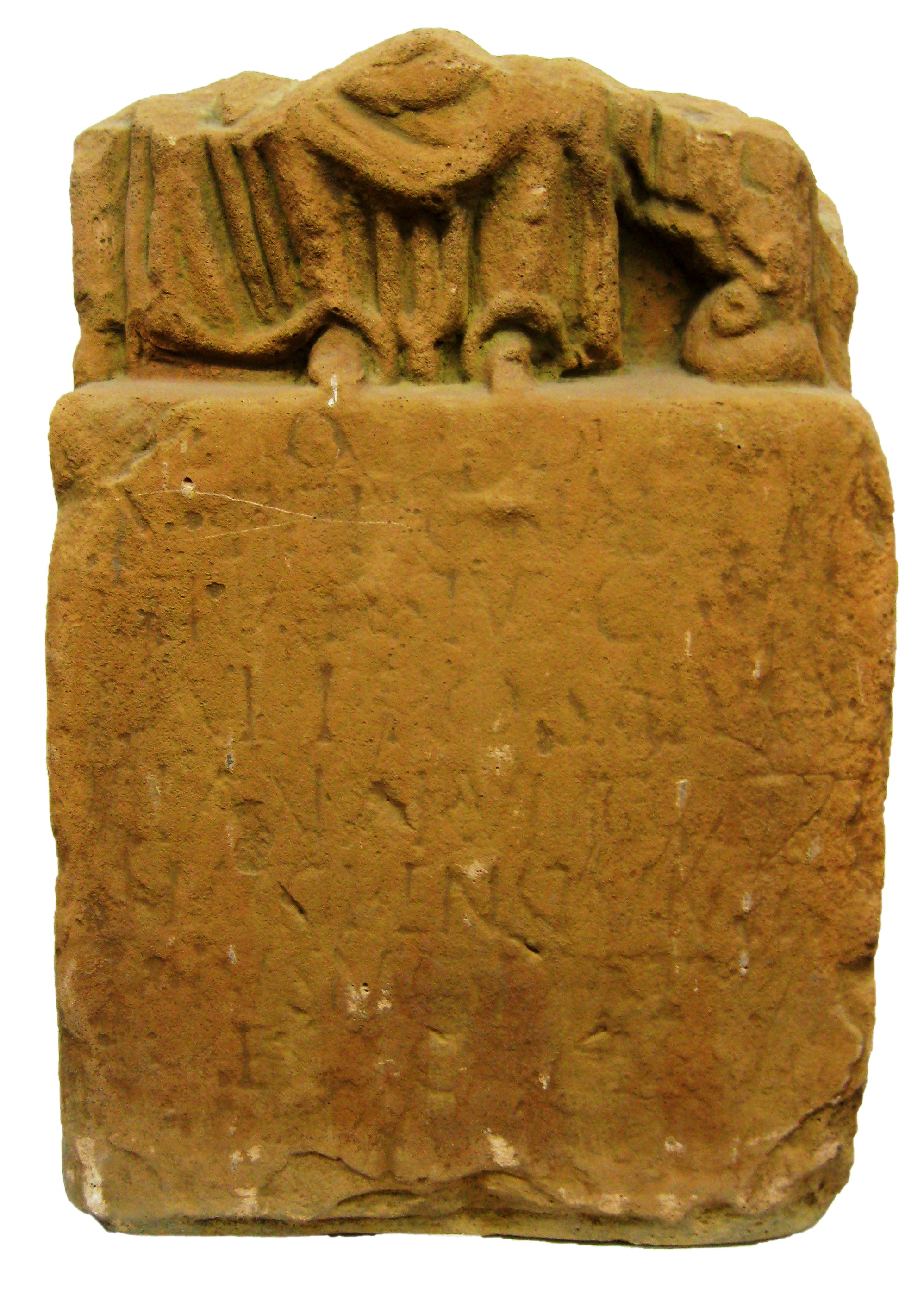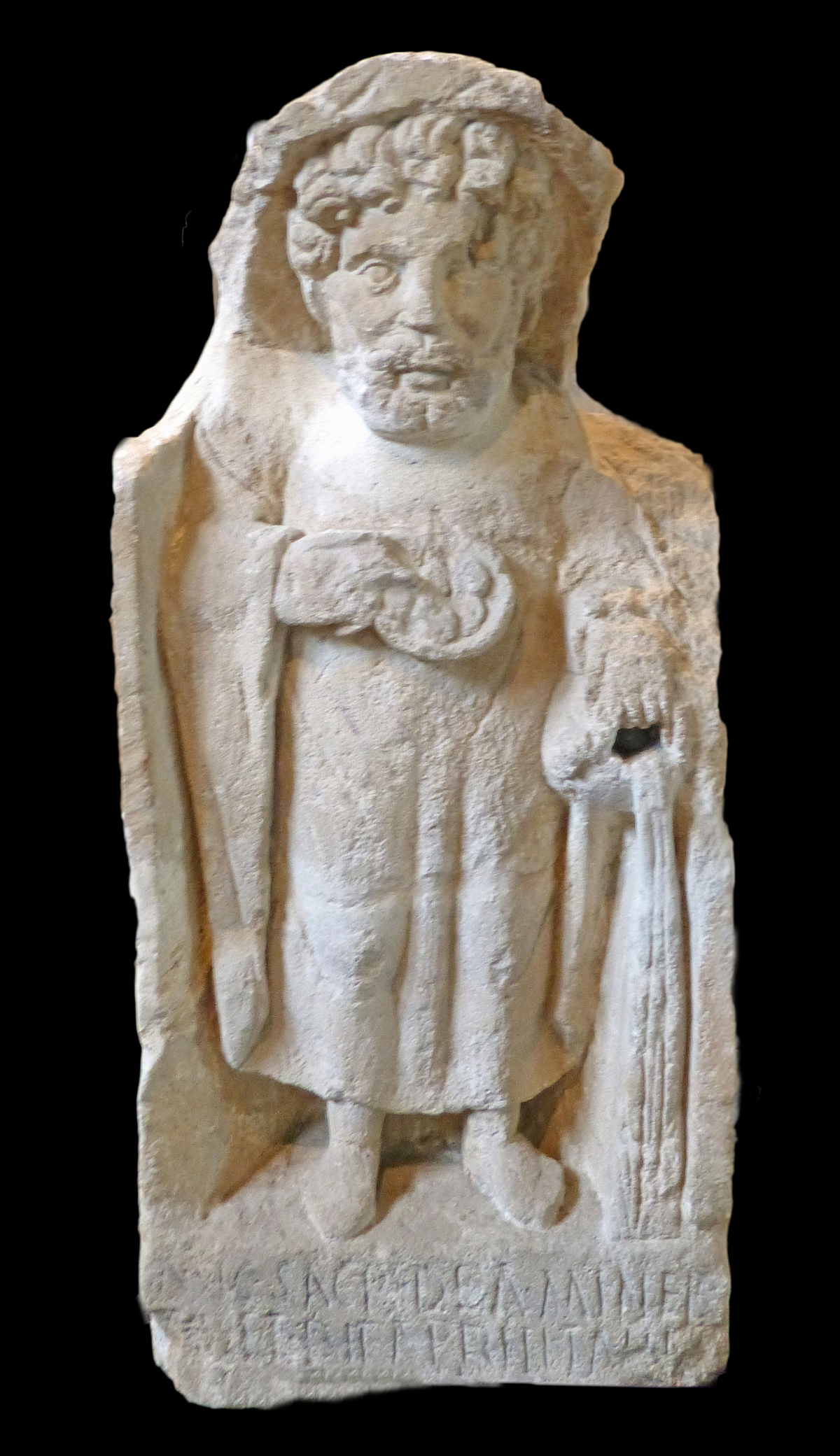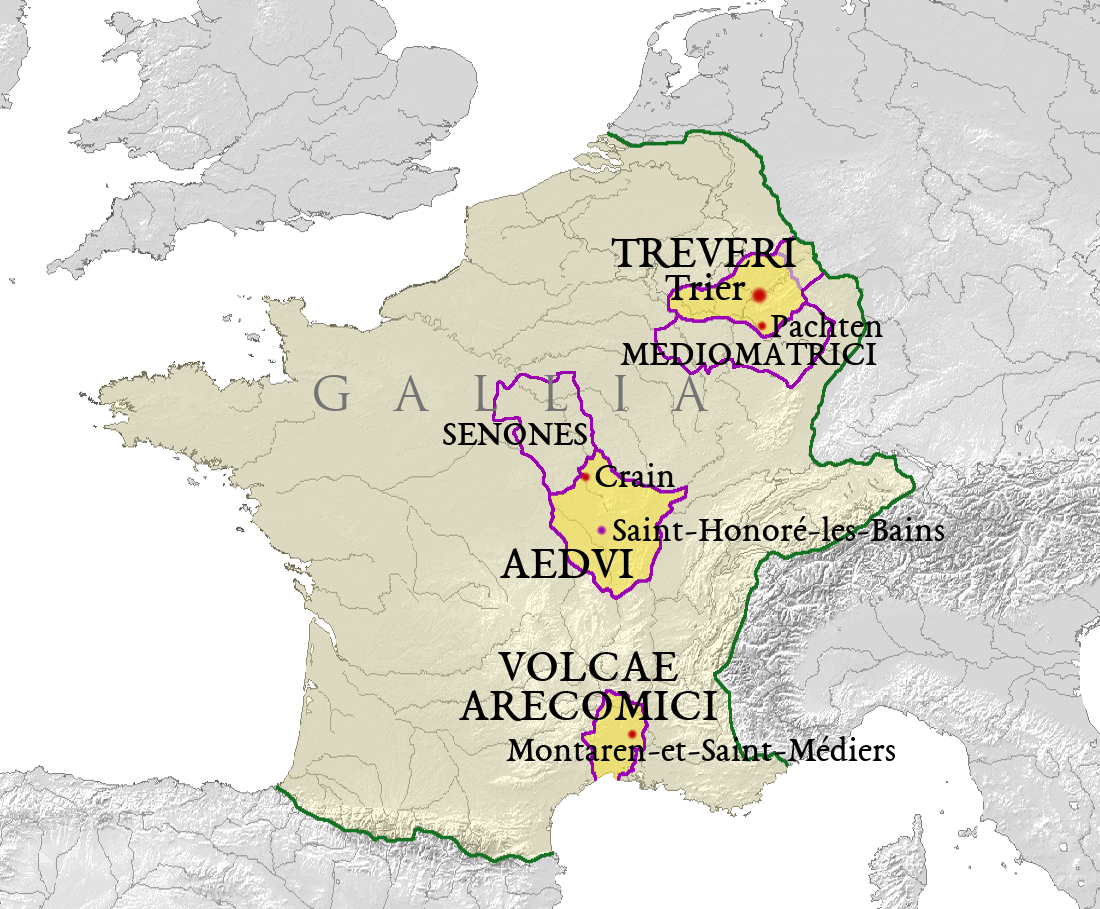DEAE RITONAE PRITONAE: to the GODDESS RITONA PRITONA
Iconography · Sites · Inscriptions · Name
Introduction
Ritona is a goddess whose name is understood to mean the ‘great ford’ or ‘ford-goddess’.Wightman, Edith Mary (1970). Roman Trier and the Treveri. Rupert-Hart-Davis, London, p 217. By some measures, she must rank as one of the most major of the ‘minor’ deities of northern and eastern Gaul. Her cultus is attested from a number of places; her worshippers include people from a diverse range of social classes and backgrounds; her connections with the imperial cultus and with such prestigious deities as Minerva, the Matronæ, Mercury, and Diana all hint at her importance. Yet there is much about her that is not known with certainty.
To explore the evidence regarding Ritona, I wrote a series of blog posts in 2016, which included my assembling a new Ritona image as well as some modern-day myth-writing. I also gave a presentation on Ritona in May of 2021 (which included a brief ritual) at the Comreton Calleios hosted by Toutâ Galation. This page will attempt to synthesize that material in a more tightly organized and less chatty format than the presentation, which, however, also delves into my personal devotional interpretation to a greater extent, so I do recommend watching the presentation and reading the blog posts if you are interested.

What remains of the Pritona sculpture at Contiomagus (Pachten).
(Photo by Wikimedia user Lokilech, CC BY-SA 3.0)
Iconography
The physical depictions of Ritona are, sadly, very scanty. There are a number of ex-votos, but really only one sculpture plainly and overtly sets out to depict her—or more accurately to depict Pritona, for the inscription uses that variant of her name. That is the fragmentary depiction of Pritona from Contiomagus or Pachten, of which the remaining part depicts Pritona’s feet (which may be a providential survival…) and enough of her legs to show that she was dressed and seated in a way reminiscent of the Mother-Goddesses of the region. She seems to have something or other on her lap (where Mother-Goddesses frequently held bowls of fruit, lapdogs, or babiesMiranda Green (1992), Symbol & Image in Celtic Religious Art, Routledge, pp. 28, 30, 33.). To Pritona’s left might be part of a cornucopia. Intriguing as it is, this depiction still leaves us wondering what Pritona would have held in her hands, whether she had anything on her head (a veil, a crown, antlers, a helmet), and whether there was anything overhead (such as birds, trees, or a nimbus).

The stele from Crain, apparently depicting a worshipper of Minerva and Ritona.
(Derived from a photo by Wikimedia user Ji-Elle, CC BY-SA 3.0)
As far as I know, the Contiomagus sculpture is the only depiction explicitly meant to show the goddess herself. On the other hand, the inscription at Crain is accompanied by a jolly-looking fellow who holds out an offering-dish, maybe with some little cakes on it, and is pouring out a libation to Minerva and Ritona. Presumably this depicts the dedicant, Aprilis Tami filius. From the Contiomagus sculpture, we know that libations and cakes are acceptable offerings to Minerva and Ritona.
Apart from her own iconography, it will be worth considering other votive remains, in this case found near the Ritona temple in the Altbachtal (a complex of temples in Trier). Pilgrims apparently deposited, near Ritona’s temple, a terracotta of Diana, three statuettes of Matronæ, two of Minerva, one of Venus, one of Fortuna, and two unidentified male busts. And there is a depiction of a cornucopia and, unusually, a votive tablet where somebody carved the outline of a pair of human feet.Gose, Erich, and Reinhard Schindler (1972). Der gallo-römische Tempelbezirk im Altbachtal zu Trier. Von Zabern, Mainz. Ritona, in other words, is associated with numerous other deities—notably the Matronæ and Minerva. And something about her is relevant to feet, as would indeed be fitting for a goddess of fords, where people can cross (on foot) rivers that would otherwise require a boat.
Cultic Sites
Ritona’s worship is attested from a variety of sites. At least two temples are known to have been dedicated to her: one in the Altbachtal in Trier, the other at Montaren-et-Saint-Médiers near Uzès in the Languedoc region of southern France. Other places where religious inscriptions mention Ritona are the Vicus Contiomagus, or modern-day Pachten (a section of Dillingen) in the Saarland, and Crain on the border of the Ædui and Senones in present-day Burgundy. An additional inscription is very fragmentary, but if it mentions Ritona, then that places a third temple also in the country of the Ædui, at modern-day Saint-Honoré-les-Bains in Burgundy, which, interestingly, is a site with hot springs.

Map of the sites associated with Ritona as well as the (approximate) boundaries of the ciuitates in which they are located.
Altogether, these sites represent the territories of three different Gallic nations (the Treveri, Ædui, and Volcæ Arecomici) in the provinces of Gallia Narbonensis, Gallia Lugdunensis, and Gallia Belgica. Two of them, moreover, are located on tribal border zones: Crain is near the border between the Senones and Ædui, while Contiomagus is near the border of the Treveri and Mediomatrici. Ritona thus is by no means limited to any particular ciuitas, and on the contrary appears to be one of those deities venerated at border shrines in order for their places of worship to be accessible to people from both communities, emphasizing their role as liminal deities of places of passage.Other deities in this category include Vosegus and Intarabus.
Geographically, there is an interesting coincidence between the Altbachtal and Contiomagus: both are sites on large rivers (the Mosella and the Sarauus or Saar, respectively) where there is a confluence with a smaller stream (the Altbach and the Prims, respectively) near a place where the bigger river can be forded or bridged. The site at Crain is also right on a river, the Icauna or Yonne.
The surroundings of these Ritona sites may be relevant as well. The Altbachtal is one of the key sacred areas of Trier, with a great diversity of shrines and altars. The fanum of Ritona—an elegant two-storey rectangular building with a wrap-around porticoWightman, Edith Mary (1970). Roman Trier and the Treveri. Rupert-Hart-Davis, London, p 217.—is in a little cluster of temples set somewhat apart from the main group in the Altbachtal. Close by, within this cluster, was a column dedicated to the god Vorio, as well as shrines to Epona, the Bull-God, Mother-Goddesses, Mercury, Aveta, and Fortuna, as well as an impressive temple that might possibly have been dedicated to Mars and Nemetona.Gose, Erich, and Reinhard Schindler (1972). Der gallo-römische Tempelbezirk im Altbachtal zu Trier. Von Zabern, Mainz. , Faust, Sabine, et al. (1996). Religio Romana: Wege zu den Göttern im antiken Trier. Rheinisches Landesmuseum Trier. It’s possible (but by no means certain) that adjacency of temples might in some cases reflect a cultic relationship of some kind.
Meanwhile, Contiomagus also furnishes evidence of worship of Mercury in the vicinity of the Ritona find.EDCS-10601197.
Inscriptions
Since there are only a handful of inscriptions to Ritona, we may as well briefly present them here. From Gallia Belgica we have four inscriptions—three from Trier, one from Pachten—all of which are in the ancient territory of the Treveri.
From Trier:
Numini[bus] / Aug(ustorum) Rito/[nae] siue ex iu[ssu Pr]/itioni[ae(?) ...] / Rasius [...] / [...] lib[er]/[t]us u(otum) s(oluit) l(ibens) m(erito)
‘For the numina of the Augusti, to Ritona or else by [order of Pr]itoni[a? ...] Rasius [......], a freedman, duly and deservedly fulfilled his vow’EDCS-06100436.
Dea(e) Ritona(e) / Pritona(e) / Arbusius / C[
‘(To) the goddess Ritona Pritona, Arbusius C...’EDCS-11201752.
[In honorem] d(omus) d(iuinae) / [deae] Riton(a)e / [aedem et] aram / [orname]ntis et do/[nis omn]ibus ue/[tustat]e co(n)su/[matis] restutu/[erunt] Catirius / [...]us et Cari/[sius Me]morialis / [
‘In honour of the divine house, to the goddess Ritona, this temple and altar with its ornaments and all its gifts, having been consumed by age, have been restored by Catirius, [...]us, and Cari[sius Me]morialis [...]’EDCS-11201753.
From Contiomagus:
[In] (h)o(norem) d(omus) [d(iuinae)] / [d(e)a]e Pritonae [...]/ninae siue Ca[...]/on(a)e pro salute / [u]ikanorum Conti/omaglensium(!) Ter/tinius Modestus [...]EC[...]
‘In honour of the divine house, to the goddess Pritona [...]nina or else Ca[...]ona for the well-being of the villagers of Contiomagus, Tertinius Modestus [...]ec[...] (dedicated this).’EDCS-10900247.
The four Treveran inscriptions show the range of people who worshipped Ritona: Roman citizens, former slaves, peregrine communities. It’s these inscriptions (and they alone) that use the name variant Pritona, which we don’t find farther south. From the inscription from Contiomagus, we can learn that the goddess Pritona was also syncretized with some other goddess, whose name unfortunately is too fragmentary for us to be sure about. It starts with CA and ends with ONA; this may be a goddess unique to the area—I haven’t been able to find a plausible candidate among goddesses known elsewhere.
Outside of Gallia Belgica, we have one unambiguous temple dedication in Languedoc, a possible one in Burgundy, and (as we have seen) a charming stele from Crain in Burgundy, which associates Ritona with Minerva.
From Montaren-et-Saint-Médiers:
L(ucius) Gellius / Sentronis f(ilius) / Ritonae aede(m) / u(otum) s(oluit) l(ibens) m(erito)
‘Lucius Gellius, son of Sentro, to Ritona (dedicated this) temple, duly and deservedly fulfilling his vow.’EDCS-09201387.
From Crain:
Aug(usto) sacr(um) dea(e) Miner[u(ae)] / [...] Rit(onae?) April(is) Tami I(ilius?) / [
‘Sacred to Augustus, to the goddess Minerva [...] Ritona, Aprilis son of Tamius (dedicated this).’EDCS-10501887.
From Saint-Honoré-les-Bains:
[Num]in[ib(us) Aug(ustis)] / [...]lli[...]iton[a]e [...] / [...] Albillius Siluius / [Albi]lli f(ilius) qui aedem / [cu]m suis omnib(us) / [or]namentis do/n[a]uit ex [u(oto)] posuit
‘To the numina of the Augusti, [...]lli[..] to [.]itona (?), Albillius Silvius son of Albillius who gave this temple with all its ornaments, set this up in fulfilment of his vow.’EDCS-10501803.
It’s worth highlighting that Ritona is mentioned on some seven inscriptions, and about four of these associate her with the imperial house or with the numina of the Augusti, hinting at some connection of Ritona with high affairs of state.
Name and etymology
Like a number of other deities—Epona, Ðirona, Damona, Maponus, and Carnonos, for example—Ritona’s name consists of a single Gaulish root followed by the divine or augmentive suffix -on-. In Ritona’s case, the root is rit-, the same that we find today in the Welsh word rhyd, meaning ‘ford’, also attested in numerous place-names ending in -ritum.Delamarre, Xavier (2003). Dictionnaire de la langue gauloise. Errance, Paris, p. 258. Thus Ritona has the plain meaning of ‘ford-goddess’ or ‘the great ford’. This is one of those roots where Celtic has lost an ancient p, from *prit- ; the same p in Germanic turns into f, giving rise to such English words as ‘ford’ and ‘firth’, while in Romance it stays p and gives us portus and hence English ‘port’. Significantly, the variant Pritona is also attested in Gallia Belgica alongside Ritona (indeed, one ancient source uses both together as dea Ritona Pritona, as we have seenEDCS-11201752.). As Gallia Belgica may at one point have been a linguistic contact zone with a pre-Celtic language (the hypothetical ‘Belgic’), it seems plausible to me that a proto-Celtic theonym *φrit-on-ā might have been borrowed into a local language that had a p, then borrowed back into Celtic after the latter had developed a p sound again. Alternatively, this may simply be one of those cases where religious language exhibits unusual archaism.
As long as we’re digging in to the minutiæ around this name, let me point out that—according to our etymology—the i should be short, as should the o (so Rĭtŏna rather than *Rītōna), while the final a is long in Gaulish and short in Latin.
I note, however, that Xavier Delamarre and some other scholars have suggested that Ritona’s name does not derive from ritu ‘ford’ but from ritus, which has a different Celtic root that sounds the same but means ‘running’.Delamarre, Xavier (2003). Dictionnaire de la langue gauloise. Errance, Paris, pp. 258–259. They sound the same in Celtic, but in Indo-European, ritus ‘running’ never had a p. As a result, this theory—not being able to account for the variant Pritona without special pleading—must be a non-starter.
Conclusions

Votive feet, carved onto a stone tablet in the Altbachtal.After Erich Gose and Reinhard Schindler (1972). Der gallo-römische Tempelbezirk im Altbachtal zu Trier. Von Zabern, Mainz.
I understand Ritona to be above all a goddess at the ford—a place where there can be a safe crossing of a river—a concept obviously laden with symbolic meaning. Although the idea of Ritona as ‘ford-goddess’ might suggest that she is a goddess of some particular ford, or that she is a water-nymph, the evidence we have seen above contradicts that interpretation. First, we find her in multiple places; and second, she has higher and more august associations as well.
The votive feet that we noted earlier might be a token of thanks to Ritona for healing a foot injury, or restoring function to feet that were lame or afflicted with gout or the like. Or, perhaps more likely, they may be in thanks for granting safe passage over a ford—an emblem of a journey successfully completed.
A ford, in such a context, might itself be symbolic—indicating a difficult passage, fraught with danger, taking a person outside of their comfort zone—perhaps even ‘crossing over’ in some kind of spiritual transformation, crossing between realms, boundaries, or ways of doing things. Then again, it might acknowledge Ritona’s help in ‘withstanding’ some literal or figurative current or obstacle. No doubt there are other possible interpretations besides—nor must such interpretations be mutually exclusive.
As a goddess at the ford, Ritona is someone we can call upon to help us find our way in unfamiliar territory—when we must advance by touch, by footfall, rather than sticking to what is clear and unthreatening. She is thus a goddess of breaking beyond previous constraints, a goddess of withstanding hazards, a goddess of transition to new opportunities. Conceived of in this way, Ritona might rightly be called upon whenever we are literally or figuratively getting our feet wet.
Notes

En français svp !

Auf deutsch, bitte!
